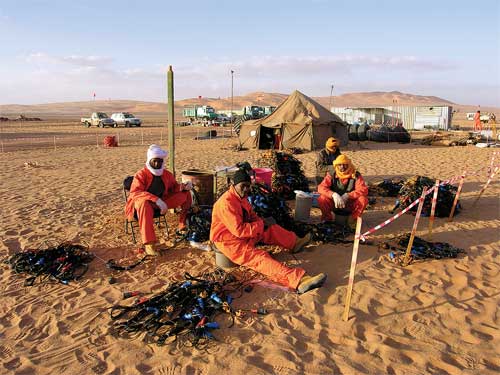OUTLOOK
Libya sees a re-birth of activity
An infusion of Western money is spurring greater exploration and development.
Gordon Feller, Contributing Feature Writer, North Africa
With the recent lifting of economic sanctions, a new day dawns for E&P in Libya, and important news is flowing out of the oil sector. In December 2007, three blocks that drew only single bidders in Libya’s latest oil exploration round were awarded to ExxonMobil, Oil and Natural Gas Corporation Ltd. (ONGC) and Inpex. The state-owned National Oil Corporation (NOC) announced that other blocs will be available quite soon. Exxon Mobil was awarded a 22.3% share in four wells, India’s ONGC a 28% share in one well and Japan’s Inpex 12.9% of three wells, said NOC. Through an auction process, Russia’s Gazprom and Russia’s Tatneft won the bulk of the licenses.
Not surprisingly, Libya wants to attract foreign investment to help it hike oil output capacity to more than 3.0 million bpd by 2010-2012 from about 1.6 million bpd at present. NOC says that less than a third of Libya has been explored.
 |
Woodside Petroleum is one of many firms attracted to Libya’s exploration potential. Photo courtesy of Woodside Petroleum.
|
|
The latest bidding round, the third since the lifting of sanctions by the US in 2004, listed 12 offshore blocks and 29 onshore areas. The onshore areas included the mature Sirte basin, the semi-mature Ghadames basin and the so-called frontier regions of Murzuq, Kufra and Cyrenaica. Libya’s upstream opportunities are very significant, and they attract a great deal of interest among Western-based majors. At the same time, these opportunities are hard to assess, given that most of the available onshore and offshore areas are still under-explored.
With only 25% of the country’s area covered by E&P concession agreements, most of Libya’s potential is still based on general assessments by NOC, several international operators (Eni, Shell, Oasis Group) and various consultancies. Most analysis indicates that Libya’s proven oil reserves are around 37 billion bbl. When one takes into account that Libya also has significant gas reserves (Western sources say 52 Tcf, Libyan officials say around 100 Tcf), increasing production and exports is well in line with expectations.
According to the US Energy Information Administration, Libya’s onshore oil has been found mainly in three geological trends of the Sirte basin: the Western Fairway, which includes several large oil fields (Samah, Beida, Raguba, Dahra-Hofra and Bahi); the north-center of the country, which contains the giant Deffa-Waha and Nasser fields, as well as the large Hateiba gas field; and an easterly trend, which has large fields, such as Sarir, Messla, Gialo, Bu Attifel, Intisar, Nafora-Augila and Amal. Overall, Sirte contains about 80% of Libya’s proven oil reserves and accounts for 90% of production. These figures, however, may be low estimates.
New areas that have recently been put forward by NOC are largely situated within the Ghadames and Murzuq basins, such as Field A in Block NC-186, Kufra in the southeastern desert and Cyrenaica-Batnan. According to the latest information available, the Ghadames basin is linked geologically with oil and gas structures in Algeria and Tunisia. Murzuq has been a successful area for exploration in recent years, and new fields include El Sharara and NC-174 (Elephant). Offshore possibilities exist, but they will be constrained by the fact that Libya has a relatively narrow continental shelf and slope.
The northern Gulf of Gabès, also known as the November Seventh concession, lies on the Libyan-Tunisian border. Since 1988, when the countries settled the border area, the Libyan-Tunisian Joint Oil Company (JOC) has been exploring a potential 3.7 billion bbl of oil and nearly 12 Tcf of gas reserves.
NOC is putting much emphasis on enhanced oil recovery (EOR) to counter on-going depletion of existing reserves. This initiative will also improve new production. Since 2002, several new projects have been put in place by NOC and its international affiliates. Government officials and consultants have suspected that Libyan oil output levels have been under pressure, due largely to the fact that existing fields are undergoing 7-8% natural decline. Libya’s challenge is to maintain production at mature fields (Sarir, Messla, Nafora, Deffa, Waha) while finding new oil discoveries to develop. Analysts expect that with production at existing fields expected to fall by around 400,000 bpd by 2010, EOR techniques could increase existing production by around 250,000 bpd.
Increased international cooperation and investment are needed if NOC is to reach governmental goals. First indications are very optimistic. The first Libyan licensing program since the 1980s, executed by NOC, has proven that international interest is immense. Of the 163 companies that registered to apply for exploration permits under the first licensing round, 63 were given the green light to submit bids.
A significant oil discovery was been made in the Murzuq basin. The field extends over two licenses, and Hydro participates in one of these. Repsol-YPF is the field’s operator. “This is one of the biggest discoveries that has been made in Libya for several years,” said Frank Dinhoff Pedersen, senior vice president responsible for Russia and North Africa in Hydro’s international business development unit.
The field was proved in late 2005, and five appraisal wells were drilled. The operator estimates that the field may contain 1.26 billion bbl of oil, of which 474 million bbl of oil will be recovered. A plan for development and operation (PDO) has been submitted to Libyan authorities. 
|



